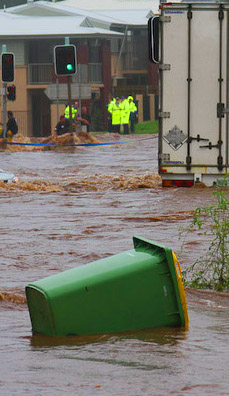QLD flood case underway
 A class action by 6,000 people has started almost 7 years after Queensland’s fatal floods.
A class action by 6,000 people has started almost 7 years after Queensland’s fatal floods.
Hearings have been told that engineers at Queensland’s Wivenhoe Dam - which was largely built to protect Brisbane against flood – “bet against” the Bureau of Meteorology's (BOM) rain forecasts.
The class action over the 2011 floods has heard that the engineers were fixated on avoiding minor damage, leading them to inaction that caused catastrophic inundations.
The class action by more than 6,000 Brisbane and Ipswich flood victims against the state of Queensland and dam operators Seqwater and Sunwater began in the New South Wales Supreme Court this week.
The lawsuit is being run in NSW because Queensland courts did not hear class actions when it was filed, though those laws were changed this year.
Maurice Blackburn barrister Julian Sexton QC, for the plaintiffs, said Wivenhoe dam operators failed to create enough space for the huge downpours that fell in early January 2011.
He said they were “unreasonably concerned” with maintaining water supply after years of drought.
They also wanted to keep rural bridges open and avoid “minor” urban flood damage, he argued, ignoring the risk of a major flood.
“Waiting for certainty is not the language of reasonable care, which focuses on probabilities, even possibilities, not on being certain that harm will occur before taking reasonable precautions,” he said.
“[Dam engineers] in effect bet that the rain which had already fallen would be all the rain that would fall and bet against the four and eight-day forecast.
“The consequence was that they failed to create sufficient storage ahead of peaking flows that came on 10 and 11 January and thus had to make a very large release on 11 January which corresponded with peak flows downstream thus causing ... greater flooding.”
Mr Sexton said that by January 11, the dam's fuse plugs risked bursting and sending uncontrolled torrents of water into the Brisbane River, leaving the dam engineers to take “drastic action” and dump 7,400 cubic metres of water a second.
He says this added to floodwaters already peaking downstream.
Dam operators have argued that four to eight-day forecasts are too unreliable, and that dam water should only be released “when rainfall has actually occurred so the effect of flood mitigation ... is known with certainty”.
Mr Sexton said this “mindset” meant there was no time to clear space for adequate storage of flooding rains upstream of Brisbane.
He said the dam operator’s logic defied “common sense” and the flood manual that was meant to guide the dams’ operation.
Dam experts are expected to appear at future session to explain the importance of “pre-empting” rainfall, clearing up storage space and not releasing water in the middle of a flood peak.
Seqwater acting chief executive Donna Gregory says the operator is “confident” the court will realise its engineers in fact “significantly reduced the impact of the flood”.
“The magnitude of the rainfall meant it was inevitable that Brisbane would flood,” she said.
Opening submissions will be heard of the next two weeks, before an adjournment until next year, after which witnesses will be called.







 Print
Print